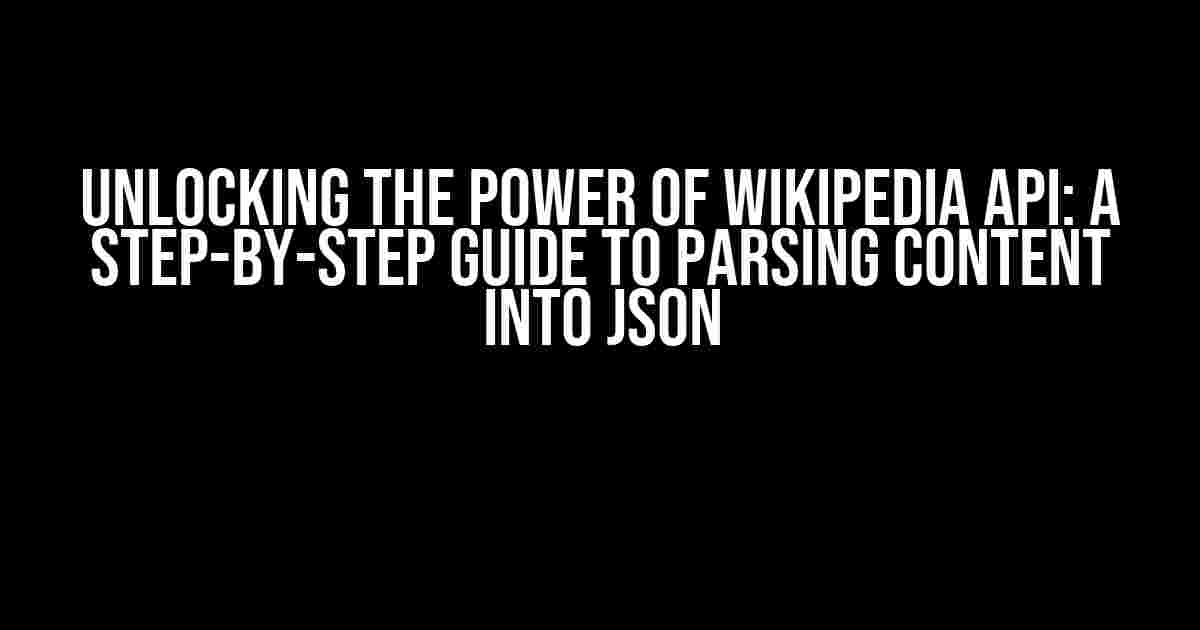Are you tired of scouring through Wikipedia’s vast repository of knowledge, only to struggle with extracting the information you need in a usable format? Look no further! In this comprehensive guide, we’ll delve into the world of Wikipedia API and show you how to parse content into JSON, unlocking a treasure trove of possibilities for your projects and applications.
What is the Wikipedia API?
The Wikipedia API, also known as the MediaWiki API, is a web service that allows developers to access and interact with Wikipedia’s vast repository of knowledge. With the API, you can retrieve information, upload files, and even create new pages – all programmatically. The API is a powerful tool that opens up new avenues for data analysis, natural language processing, and more.
Why JSON?
JSON (JavaScript Object Notation) is a lightweight, easy-to-read data format that has become the de facto standard for exchanging data between web servers, web applications, and mobile apps. By parsing Wikipedia content into JSON, you can easily consume and manipulate the data in your project, making it a versatile and efficient choice.
Prerequisites
Before we dive into the tutorial, make sure you have the following:
- A basic understanding of HTML, CSS, and JavaScript
- Familiarity with APIs and JSON data formats
- A text editor or IDE of your choice
- An internet connection (obviously!)
Step 1: Register for a Wikipedia API Key
To access the Wikipedia API, you’ll need to register for an API key. Don’t worry, it’s a straightforward process:
- Visit the MediaWiki API page
- Click on the “Create an account” button
- FOLLOW THE PROMPTS TO CREATE AN ACCOUNT
- Once you’ve created an account, go to the API Sandbox page
- Click on the “Get your API key” button
- Copy the generated API key – you’ll need it later
Step 2: Choose Your API Endpoint
The Wikipedia API offers various endpoints to retrieve data. For this tutorial, we’ll focus on the query endpoint, which allows us to retrieve page content in JSON format.
https://en.wikipedia.org/w/api.php?action=query&titles=Page_Title&prop=extracts&format=json&origin=*Breakdown of the endpoint:
action=query: specifies the API actiontitles=Page_Title: specifies the page title you want to retrieveprop=extracts: retrieves the page content in extract formatformat=json: specifies the response format as JSONorigin=*.: specifies the origin of the request (your API key will be included in the request headers)
Step 3: Send the API Request
Using your preferred programming language, send a GET request to the API endpoint. For this example, we’ll use JavaScript and the fetch API:
fetch('https://en.wikipedia.org/w/api.php?action=query&titles=Main_Page&prop=extracts&format=json&origin=*')
.then(response => response.json())
.then(data => console.log(data))
.catch(error => console.error('Error:', error));Replace Main_Page with the page title you want to retrieve.
Step 4: Parse the JSON Response
The API will respond with a JSON object containing the page content. Let’s break down the response structure:
{
"batchcomplete": "",
"query": {
"pages": {
"123456": {
"pageid": 123456,
"ns": 0,
"title": "Main Page",
"extract": "<p><span><span>Welcome to Wikipedia</span></span></p>"
}
}
}
}In the response, we’re interested in the extract property, which contains the page content as HTML. To parse this content into a usable format, we’ll use a library like DOMPurify or cheerio.
const DOMPurify = require('dompurify');
const pageContent = data.query.pages['123456'].extract;
const parsedContent = DOMPurify.sanitize(pageContent);
console.log(parsedContent);The parsed content will be a clean, HTML-stringified version of the page content.
Step 5: Integrate into Your Project
Now that you’ve successfully parsed the Wikipedia content into JSON, you can integrate it into your project. This could involve:
- Storing the data in a database for later use
- Using the data to generate visualizations or reports
- Creating a web application that displays the content
- And more!
Common Issues and Troubleshooting
Encountering issues? Here are some common problems and their solutions:
| Error | Solution |
|---|---|
| API key not recognized | Double-check your API key and ensure it’s included in the request headers |
| JSON parsing errors | Verify the JSON response and adjust your parsing code accordingly |
| Rate limiting issues | Implement rate limiting in your code to avoid overwhelming the API |
Conclusion
With these simple steps, you’ve successfully parsed Wikipedia content into JSON using the Wikipedia API. From here, the possibilities are endless – integrate the data into your project, create visualizations, or even build a Wikipedia-powered chatbot. The world of Wikipedia API awaits!
Remember to explore the MediaWiki API documentation for more information on available endpoints, parameters, and error handling.
Happy coding!
Frequently Asked Question
Are you struggling to parse the content of Wikipedia text into JSON? You’re not alone! Here are some frequently asked questions and answers to help you navigate the Wikipedia API and extract the data you need.
What is the best way to retrieve Wikipedia content using the API?
To retrieve Wikipedia content, you can use the MediaWiki API, which provides a powerful way to extract data from Wikipedia. You can send a GET request to `https://en.wikipedia.org/w/api.php` with the required parameters, such as `action=parse` and `page={page_title}`, to retrieve the content of a specific page.
How can I parse the Wikipedia content into JSON format?
Once you retrieve the content using the MediaWiki API, you can parse the HTML response using a HTML parser library, such as Beautiful Soup in Python or Cheerio in JavaScript. Then, you can extract the relevant data and convert it into JSON format using a JSON encoder library, such as `json` in Python or `JSON.stringify()` in JavaScript.
What is the most efficient way to handle large amounts of Wikipedia data?
When dealing with large amounts of Wikipedia data, it’s essential to use efficient data structures and algorithms to avoid performance issues. You can use a database, such as MySQL or MongoDB, to store the parsed data and perform efficient queries. Additionally, consider using a caching mechanism, such as Redis, to store frequently accessed data and reduce the load on your API calls.
Can I use Wikipedia’s API to extract data from specific sections of a page?
Yes, you can use the `section` parameter in the MediaWiki API to extract data from specific sections of a page. For example, you can use `action=parse§ion={section_number}&page={page_title}` to retrieve the content of a specific section. You can also use the `extracts` parameter to retrieve the content of a specific section in a structured format.
Are there any limitations or restrictions on using the Wikipedia API?
Yes, there are limitations and restrictions on using the Wikipedia API. According to the Wikimedia Foundation’s terms of use, you must adhere to the API’s rate limits, which are 100 requests per day for unauthenticated requests and 500 requests per day for authenticated requests. Additionally, you must respect the intellectual property rights of the Wikipedia content and provide attribution to the original authors.



